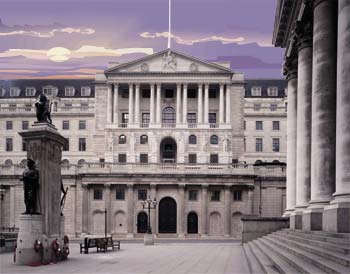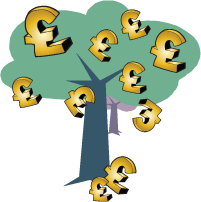 Money doesn’t grow on trees...
Absolutely right! Our bank notes ‘grow’ in fields… of cotton! Yes, our notes are made of cotton, that’s what gives genuine notes that special crisp feel. This is important, because it’s how our bank notes are produced and designed that makes them so trusted – AND SO VALUABLE.
 Over the last two issues of Oink! we’ve taken a look at how money has evolved. But it wasn’t until 1694, when the Bank of England helped finance the King’s war against France, that the foundations of banking were established. People would deposit their gold at the Bank, and the Bank would issue them with a note, stating the value of that gold. Everyone trusted the Bank to keep the gold safe and return it in exchange for one of these notes, so they began using the notes to pay for things. Over the last two issues of Oink! we’ve taken a look at how money has evolved. But it wasn’t until 1694, when the Bank of England helped finance the King’s war against France, that the foundations of banking were established. People would deposit their gold at the Bank, and the Bank would issue them with a note, stating the value of that gold. Everyone trusted the Bank to keep the gold safe and return it in exchange for one of these notes, so they began using the notes to pay for things.
That same trust continues today even though you won’t be given gold. Look at any bank note: it says quite clearly, ‘I promise to pay the bearer…’ But how do we know that the notes we have in our pocket are real, and, therefore, that the promise can be relied upon?
 That’s the Bank’s job. Each bank note has many security features incorporated in its design and manufacture. Study one and see. The paper feels crisp. The print is sharp and the colours clear, slightly rough to the touch because of the raised printing where the words “Bank of England” appear on the front of the note. Hold it up to the light: you’ll see a watermark of the Queen. Gently move a £5, £10 or £20 around and discover the silver foil changing from a brightly coloured symbol of Britannia to a number. £50 notes don’t carry a foil hologram but have a complex silver patch of a rose and medallion. That’s the Bank’s job. Each bank note has many security features incorporated in its design and manufacture. Study one and see. The paper feels crisp. The print is sharp and the colours clear, slightly rough to the touch because of the raised printing where the words “Bank of England” appear on the front of the note. Hold it up to the light: you’ll see a watermark of the Queen. Gently move a £5, £10 or £20 around and discover the silver foil changing from a brightly coloured symbol of Britannia to a number. £50 notes don’t carry a foil hologram but have a complex silver patch of a rose and medallion.
The £5, £10 and £20 notes have a fluorescent feature which reveals a multicoloured number when placed under a good-quality ultra violet light. You’ll often see shopkeepers using them! And, as an extra measure of security, the same notes have some very small writing printed as part of the intricate design under the Queen’s portrait, consisting of words and numbers. But, you’ll need a magnifying glass to read this. Now that you know what to look out for, in the unlikely event you do come across a counterfeit bank note, hand it to your parents or your teacher.
Remember, only the Bank of England can truly ‘Promise to Pay’; that’s why we can all trust the notes we use every day.
www.bankofengland.co.uk/banknotes
 back back
|






 Over the last two issues of Oink! we’ve taken a look at how money has evolved. But it wasn’t until 1694, when the Bank of England helped finance the King’s war against France, that the foundations of banking were established. People would deposit their gold at the Bank, and the Bank would issue them with a note, stating the value of that gold. Everyone trusted the Bank to keep the gold safe and return it in exchange for one of these notes, so they began using the notes to pay for things.
Over the last two issues of Oink! we’ve taken a look at how money has evolved. But it wasn’t until 1694, when the Bank of England helped finance the King’s war against France, that the foundations of banking were established. People would deposit their gold at the Bank, and the Bank would issue them with a note, stating the value of that gold. Everyone trusted the Bank to keep the gold safe and return it in exchange for one of these notes, so they began using the notes to pay for things. That’s the Bank’s job. Each bank note has many security features incorporated in its design and manufacture. Study one and see. The paper feels crisp. The print is sharp and the colours clear, slightly rough to the touch because of the raised printing where the words “Bank of England” appear on the front of the note. Hold it up to the light: you’ll see a watermark of the Queen. Gently move a £5, £10 or £20 around and discover the silver foil changing from a brightly coloured symbol of Britannia to a number. £50 notes don’t carry a foil hologram but have a complex silver patch of a rose and medallion.
That’s the Bank’s job. Each bank note has many security features incorporated in its design and manufacture. Study one and see. The paper feels crisp. The print is sharp and the colours clear, slightly rough to the touch because of the raised printing where the words “Bank of England” appear on the front of the note. Hold it up to the light: you’ll see a watermark of the Queen. Gently move a £5, £10 or £20 around and discover the silver foil changing from a brightly coloured symbol of Britannia to a number. £50 notes don’t carry a foil hologram but have a complex silver patch of a rose and medallion.






